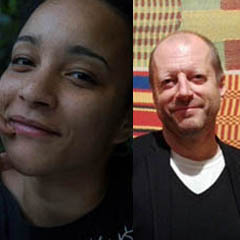
Leonie Chima Emeka & Stefan Eisenhofer
Born 1984 in Nairobi (Kenya), Armitage received his artistic training in London (UK). Living and working in both places today, he praises each of these cities as substantial to his creative practice. His inspirations spring from many different sources – from political events, mass media affairs and pop culture to personal memories and experiences as well as from Eastern African and European folklore. He merges together the stories and experiences of two cities and weaves them into a narrative of interregional interest. Often starting with Kenyan local myth he is developing global tales of political critique and rebellion concerning global demands on democracy, data protection, ecological and human rights — always overlaid by the meaning of the break between the “West and the Rest”, between human and un-human, between the exploitation of life and its inviolable dignity. In his work, Armitage investigates the idea of Africa as a mirror for Western phantasies and success stories of the Global North: the wild and untamed nature on the one side and the violated racialized bodies and political and ecological catastrophes on the other.
The painting “Baboon” was on view in the exhibition "The Paradise Edict“ at Haus der Kunst in 2020 as part of a series of five oil paintings depicting tropical animals. On tropical background various monkeys in erotic posture invite the viewer to an examination of sexuality at the boundaries between animality and humanity, erotics and exotics. Also the “Baboon” strikes the eye with its suggestive sexuality. In the clearing of an overgrown rainforest, the monkey lies on the ground in a very human attitude. A bare stone supports its right arm as if the ape was resting on a natural chaiselongue. Within the apparently wild environment, the animal seems rather cultivated.
The baboon oscillates between human and animal; not only in its posture but also in its physique: Feet and face are animal, while the rest of its body looks almost human; it has no fur or hair but pronounced muscles on his bare chest. Despite its muscles the ape’s body looks youthful and slightly lanky. It reminds to Michelangelo’s David for which it is commonly known that the legs and arms are extra-long compared to his body in order to mark his youth. Like a juvenile not yet fully grown the baboon, too, has long arms and legs. Neither a child nor yet a man, both an ape and a human body, the baboon hovers between child and man, between man and animal, between innocence and animal sexuality.
Instead of the characteristic fig leaf of early modern European sculpture, there is a large bundle of bananas between the monkey's legs. The individual bananas, sketched on the yellow surface, are quite phallic in shape and the banana bundle tends to overemphasise the male sexual organ, while the ape’s physical penis is hidden behind it. The banana is probably the most common fruit in the Global North that still bears the tag ‚exotic‘. It is not the monkey’s body, that is sexual; but the bundle of bananas both hides and emphasises the phallic and states an allegory for the conceptual connection between exotic and phallic.
Its absence makes it ever more present, as its leaves the concretisation of sexuality to the viewer’s imagination. In fact the image could be both innocent or sexual, as not only the penis is hidden behind the bundle, but also the ape’s left hand that reaches out to his underbelly. We can not see, but only guess where it rests, and what it is doing there. In his suggestiveness Armitage opens a space of confusing erotic tension and a critique of the sexualisation of race. With the figure that hovers between youth, man and animal, Armitage challenges the relations between black masculinity and sexuality in the Global North. It was Franz Fanon in "Black Skin-White Masks“ (1952), who once posited, that in European Subconscious "the Negro“ is the genitals par exellence, reduced to a giant penis. In this painting Armitage investigates the complex relations between blackness and phallus in Western concepts of masculinity.
Like many of Armitage’s paintings also the “Baboon” presents an overlay of heaven and hell and is taking up the title of the exhibition “Paradise Edict”. They are referring to African and European as well as global paradise fantasies and hopes. They are aiming often at an ordered, decreed and prescribed paradise. They reveal the mandatory and obsessive aspects of these Garden of Eden-Imaginations, disillusioning global Out-of-Africa-fantasies, distorting eternal and natural laws to man made illusionistic laws.
Armitage uses lubugo, a fabric made from fig-tree bark, in lieu of canvas for his paintings. This cloth is Ugandan in origin and has a long history of social, religious and political meaning and use there. Armitage first came across lubugo in 2010 on a Nairobi tourist market. The use of this now somewhat Pan-East-African-material corresponds with his visual vocabulary. Armitage combines European with Eastern-African materials, forms and strategies and waves them into complex, yet alluring compositions that remember the entangled history of painting through the ages and continents and rewrites new relations in between.
published January 2021
About Michael Armitage's initiative in Nairobi "Nairobi Contemporary Art Institute (NCAI)" see Link.

